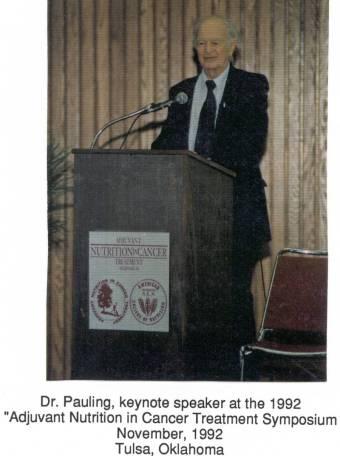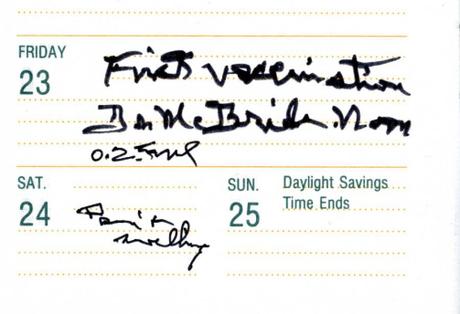
Medical Tribune, September 10, 1992.
[An examination of the final years of Linus Pauling’s life. Part 2 of 4.]
In February 1992, Linus Pauling announced publicly that he had cancer. His critics responded with sentiments that were, at times, distinctly unsympathetic. In their view, since Pauling had been advocating vitamin C as a preventative treatment for cancer for years, his diagnosis undermined those decades of work. Pauling retorted that most elderly men develop hyperplasia or cancer in their prostates, often by age 70. Pauling believed it was quite likely, although not provable, that his high intake of vitamin C delayed the inevitable by decades.
As Pauling continued to struggle with the limitations that his illness placed upon him, his new caretaker, ranch-hand Steve Rawlings, became an important part of his life. Rawlings did a lot of the day-to-day work of providing for Pauling while he was ill, a time period during which Pauling increasingly sought out the solace and solitude of his isolated home on the Pacific Coast. Linus Pauling Institute of Science and Medicine (LPISM) administrator Steve Lawson would later reflect on the importance of Pauling’s Big Sur residence at Deer Flat Ranch during the last few years of his life. In a 2011 interview, Lawson explained,
When he was in Palo Alto, Pauling’s time was sought by many people for many different reasons: old friends, colleagues, the public, the media. When he retreated to Deer Flat Ranch, he removed himself from that. I think he really loved that time alone down there. I know that he liked to watch some programs on T.V., some serialized programs. He read quite a lot. He loved to read mystery books. He was a rare individual in that there was really no division between what he did recreationally and what he did professionally. He was a scientist through and through, and derived pleasure from working on scientific problems. Often times if you go into someone’s bathroom, you’ll find a Prevention magazine, a Reader’s Digest, or Entertainment Weekly, or Time, or the newspaper. Pauling’s bathroom was stacked with scientific journals. He wasn’t physically vigorous [by the early 1990s], but he certainly didn’t seem fatigued.
With his time becoming increasingly precious, Pauling’s coworkers, friends, and family all felt that he should do what he most wanted to do with his days, and this had always been to focus on science. Freed from the responsibility of running the LPISM’s day-to-day operations, Pauling continued to work at Deer Flat Ranch in spite of his worsening health problems.
Of particular interest was the fact that, stricken with cancer himself, Pauling’s scientific fascination with the disease only intensified. Rather than remove himself from ongoing cancer research as his disease advanced, he instead committed even more fully to this cause in his final years. In particular, Pauling became increasingly interested in non-toxic methods of cancer therapy; methods, in other words, that were far less stressful on the body than are radiation or standard chemotherapy regimens.
In a paper co-authored with Drs. David Knight and Abram Hoffer, he worked to determine survival rates among over 2,000 cancer patients receiving high doses of vitamin C and other nutrients. He even flew to Tulsa, Oklahoma in October 1992 for a conference on alternative treatments of cancer. He likewise continued to work to convince American physicians of the value of vitamin C and lysine in preventing and treating heart disease, a notion that was gradually beginning to gain small slivers of recognition in the medical community.

Privately, Pauling was waging a personal war on his disease, exploring avenues of immunotherapeutic treatment that were unorthodox in the medicine of the time but which have, in recent years, begun to show great promise.
In a letter to medical writer and cancer consultant Ralph Moss, Pauling detailed a therapy involving autologous anticancer antigen preparation, or AAAP, of which he was somewhat skeptical but nonetheless interested in pursuing further. Working with friends and colleagues at Stanford Medical School to raise monoclonal antibodies against his prostate cancer cells, Pauling ultimately conducted what amounted to exploratory and self-experimental science to discern the potential value of AAAP.
Pauling’s first exposure to the idea of AAAP came from the work of Duncan McCollester, a medical doctor based in Irvington, New York, who advocated for a form of “Active Specific Immunotherapy.” This treatment involved the use of a manganese phosphate gel that was mixed with isolated portions of tumor tissue in which tumor antigens had been converted to a form capable of stimulating a cancer-destroying immune response in the patient upon re-administration on the forearm or thigh. McCollester dedicated a book on the subject to Pauling, even as he was struggling to receive FDA approval for the treatment.
David Stipp, a reporter for the Wall Street Journal, reported in August 1992 that a similar medical treatment had been developed by Cellcor, Inc. of Newton, Massachussetts. Cellcor offered customers a treatment for kidney cancer in which a patient’s own white blood cells were extracted, treated in such a way as to make them attack tumor cells, and then reintroduced into the patient’s cells. Known as autolymphocyte therapy, or ALT, the treatment had been available commercially in Atlanta, Boston, and Orange County, California since around 1990. However, at the time, medical officials disputed the efficacy of Cellcor’s anti-cancer therapy, arguing that not enough data had been collected to substantiate the company’s claims.
By July 1992, Pauling had decided to move forward with AAAP treatment, the ultimate goal being a vaccine that would combat his own illness while also providing useful data for the science of the future. Subsequently, a 1 gram section of cancerous tumor tissue that had been surgically removed from Pauling’s body was shipped to McCollester’s lab in New York. Upon entering the operation, Pauling’s surgeon had advised him that his entire tumor should be removed, rather than a small section. Pauling refused this request, arguing that a full resection would prevent him and others from observing the effectiveness of the AAAP treatment. In other words, rather than focusing on the fact that his own life was on the line, Pauling was still operating, first and foremost, in the mode of the scientist: he was running an experiment in which he himself was a test subject, and the stakes could not have been higher. In Pauling’s mind there were plenty of reasons for optimism.

Pauling notes his first AAAP injection on October 23, 1992.
By October, scientists at Stanford University, led by Dr. Ronald Levy, had successfully boosted the immune systems of a small group of B-cell lymphoma patients using a vaccine that had been genetically engineered from the patients’ own tumor tissues. In two of these nine patients, tumors vanished completely.
In generating the vaccines for each individual patient, the Stanford scientists created clones of the cancerous B-cells from each subject, and then separated out specific proteins – known as receptors – from the outer coatings of the B-cells. Using genetic engineering techniques, the scientists then added other proteins that boosted the immune system and created a synthetic version of the engineered receptors. The result was a tailor-made vaccine created from the B-cell receptors that used each patient’s immune system to attack cancer cells.
Pauling’s confidence in his anti-cancer antigen treatment was likewise elevated by other immunotherapy techniques then being developed by a team at the National Cancer Institute, as headed by Dr. Steven Rosenberg, Dr. French Anderson, and Dr. Michael Blaese. However, these studies were all specific to skin cancer, and were carried out on patients already in remission and receiving chemotherapy, or on patients with very small tumors. Pauling, by contrast, was already afflicted with advanced prostate cancer by the time that his condition was discovered, and he had not yet accepted any form of radiation therapy.
From October 1992 on, Pauling almost exclusively used the AAAP vaccine and vitamin C to treat his cancer. The vaccine traveled from McCollester’s lab in New York to a willing physician in California who had agreed to administer Pauling with the suggested injections- anywhere from 0.2 to 0.65 ml of vaccine a few times monthly. Pauling continued to receive these injections, which routinely caused tenderness and swelling, until January 1994, about seven months before he died.
